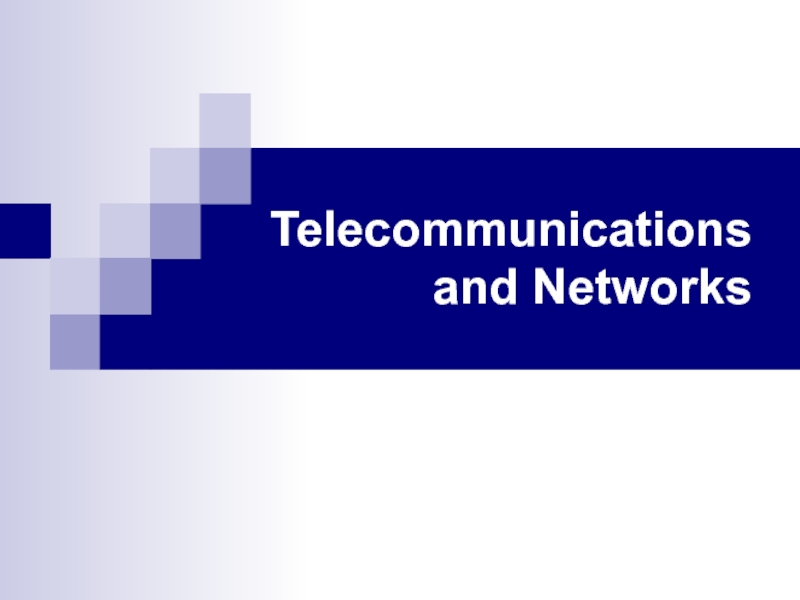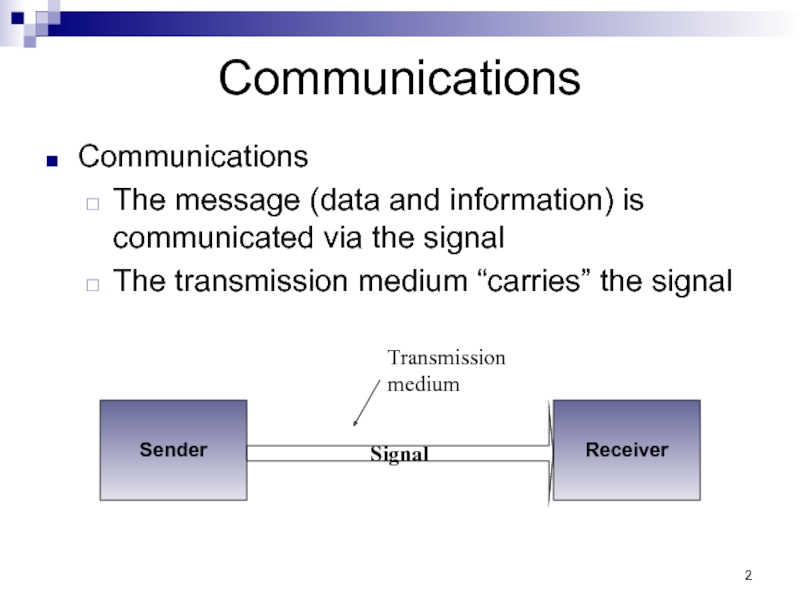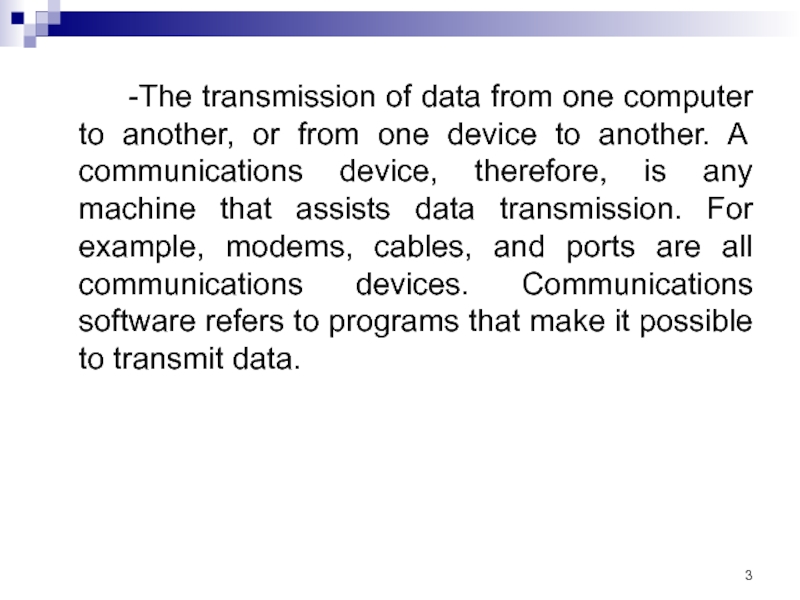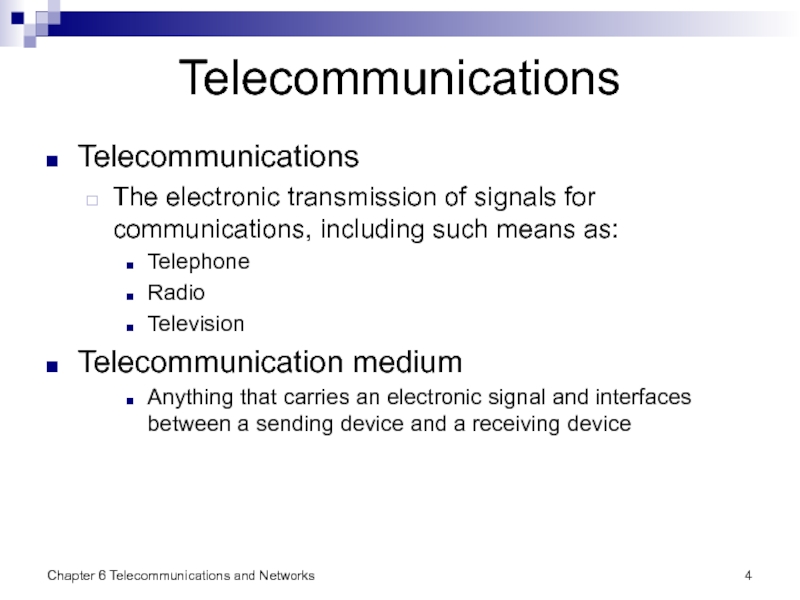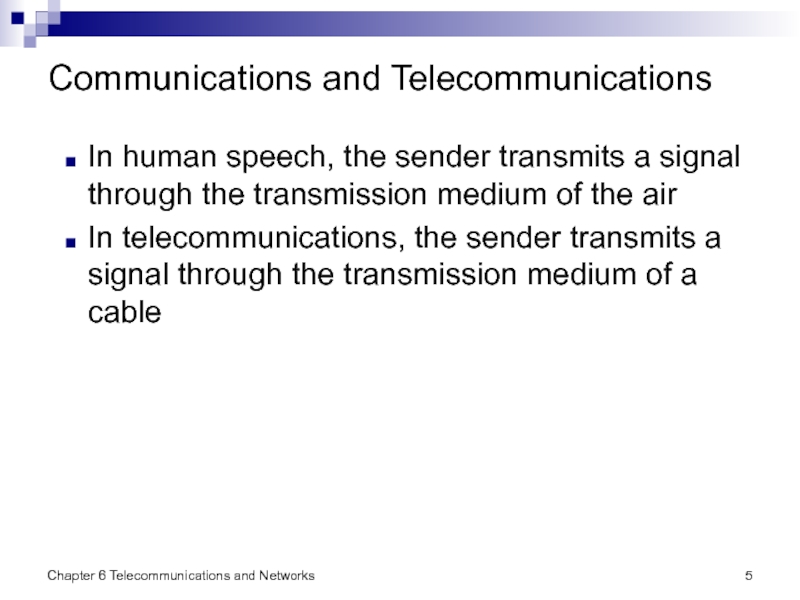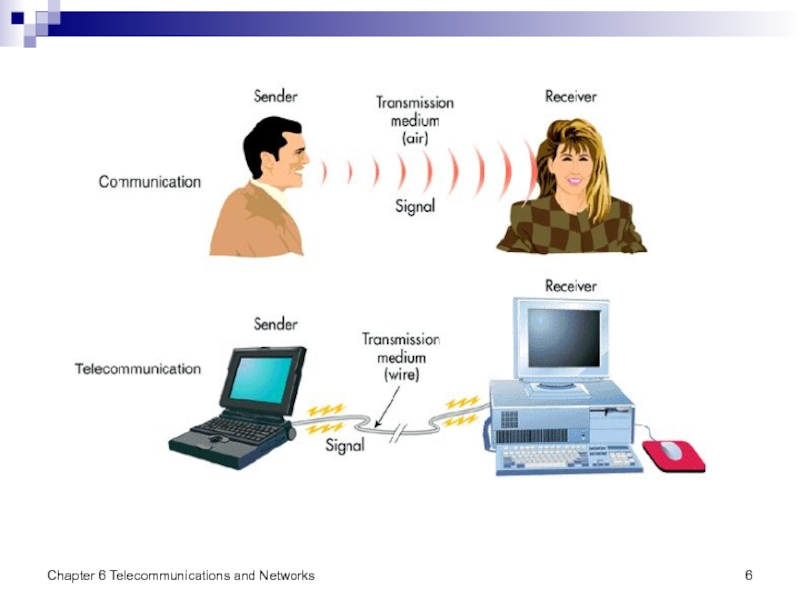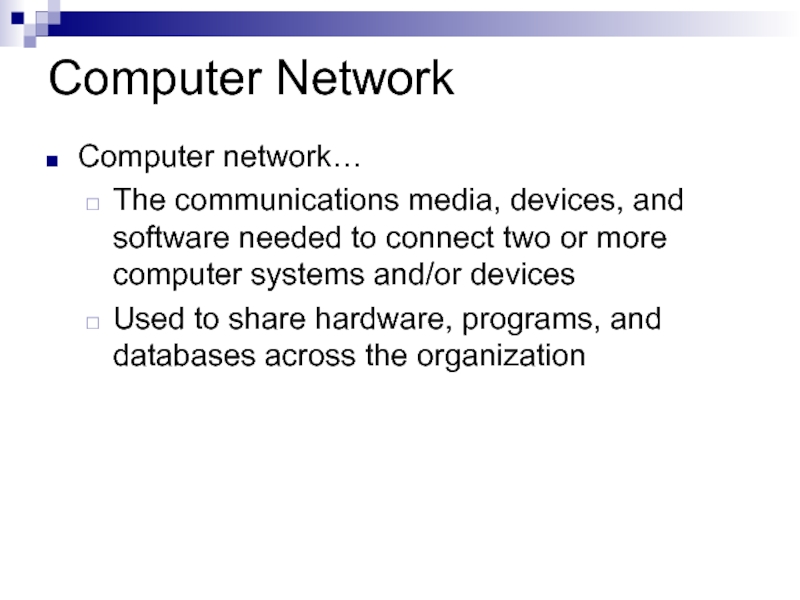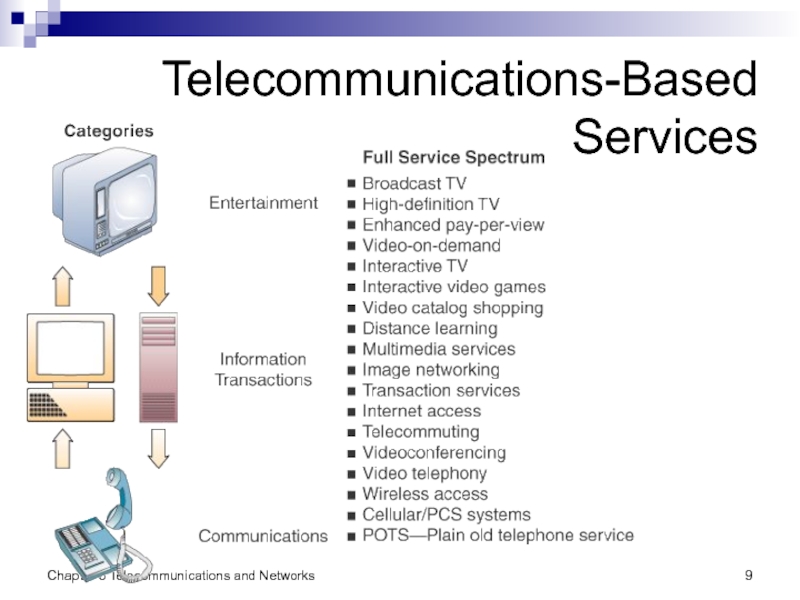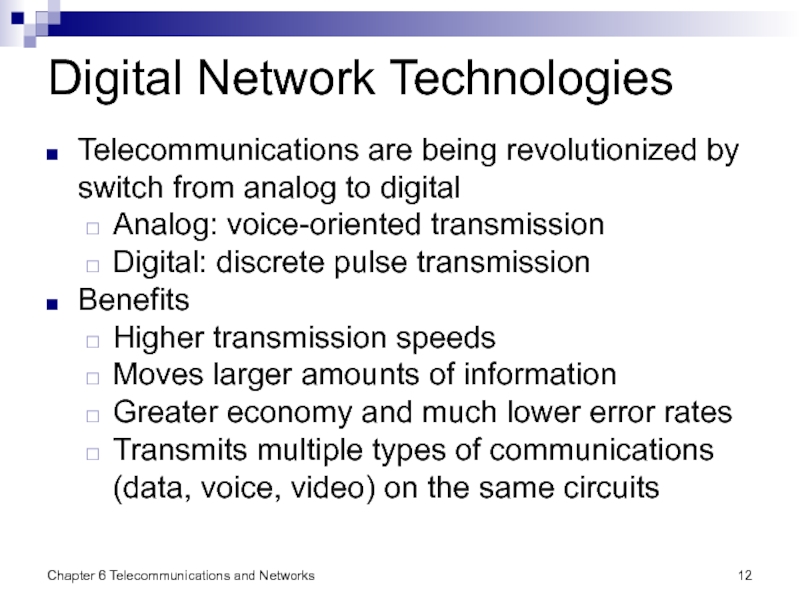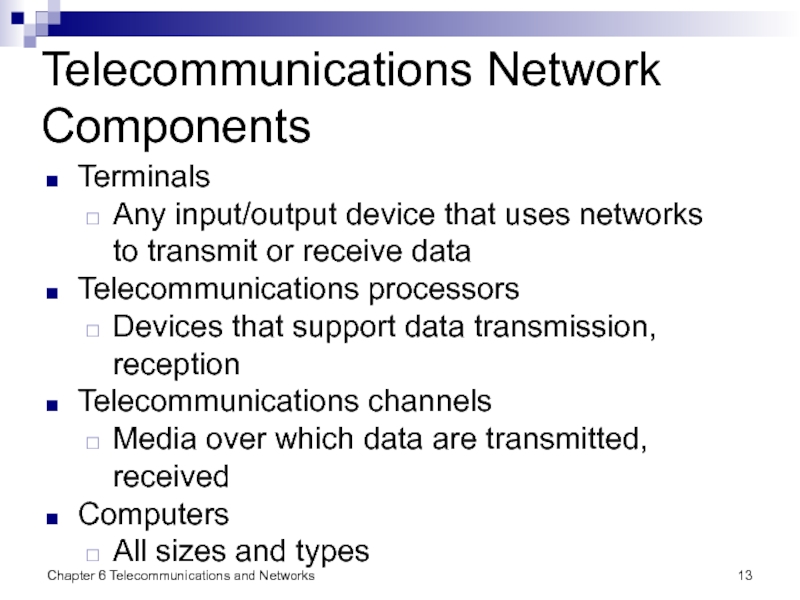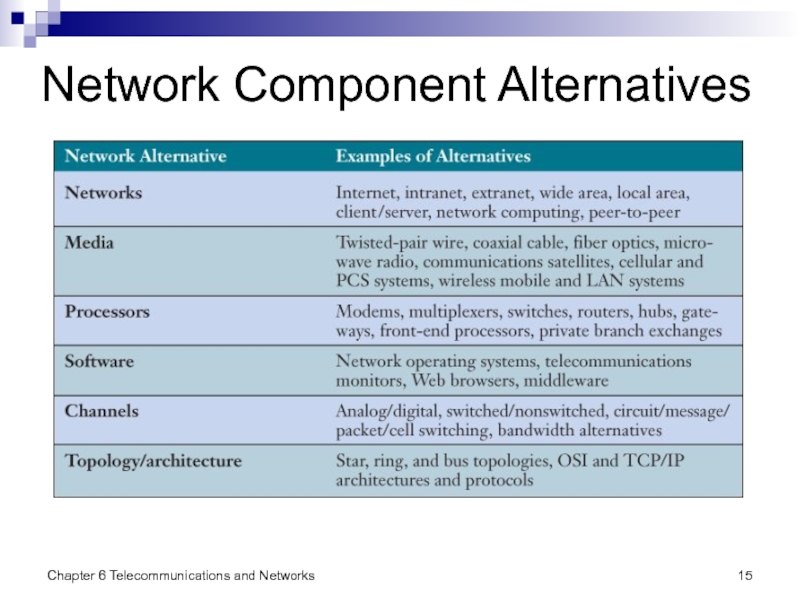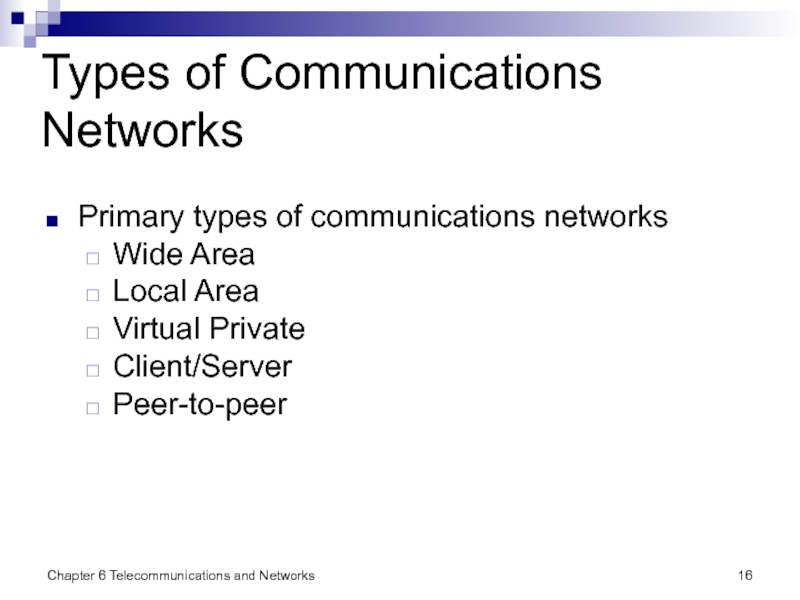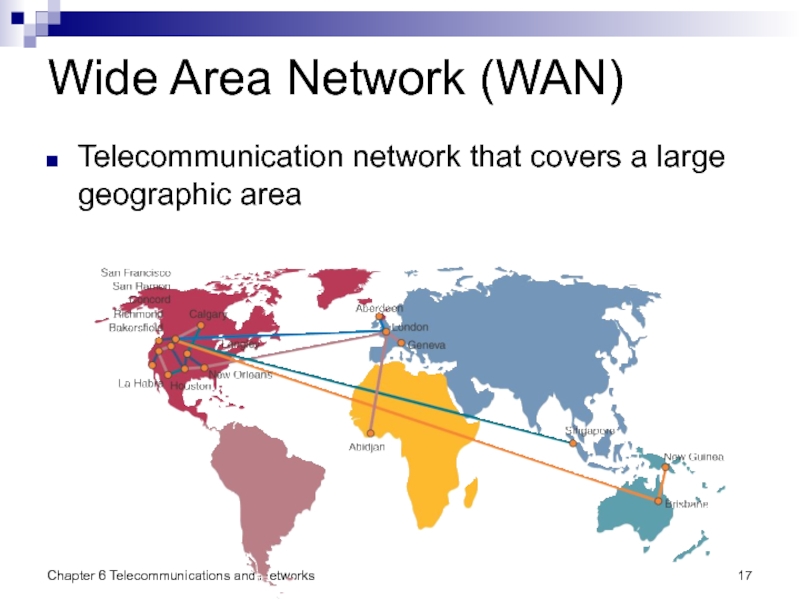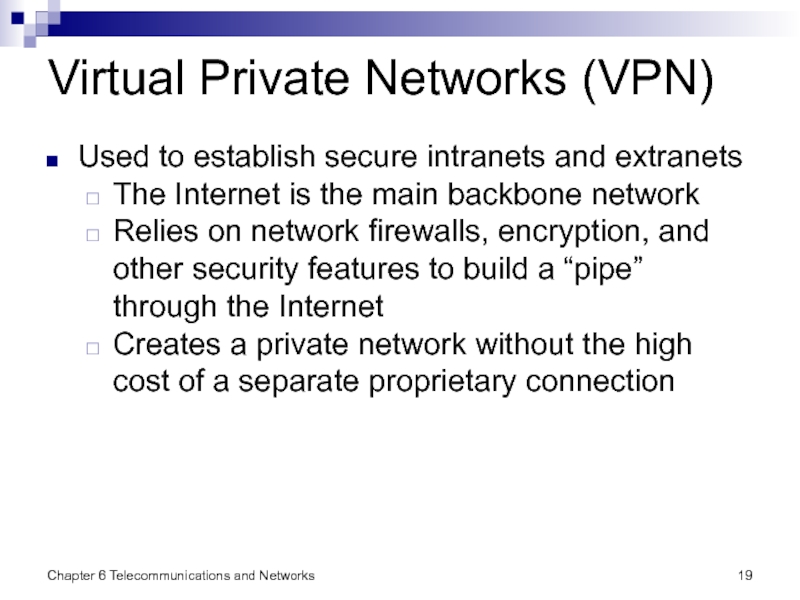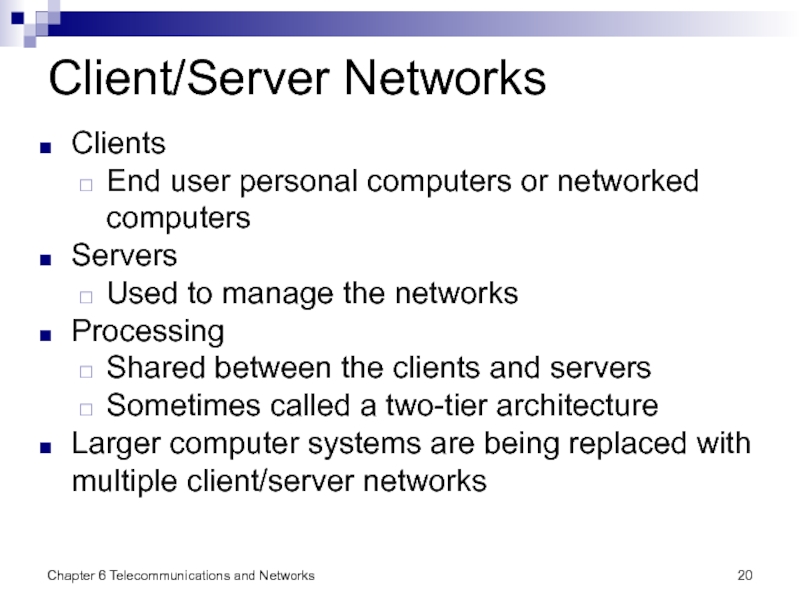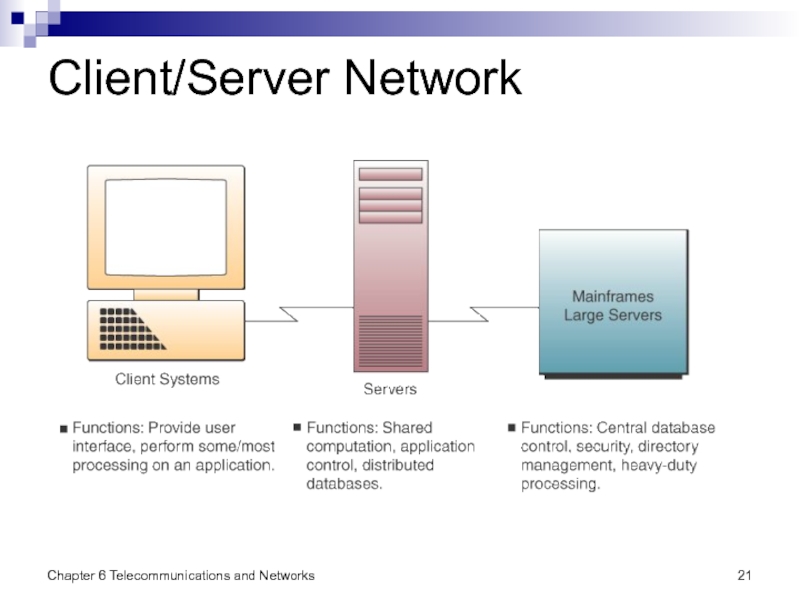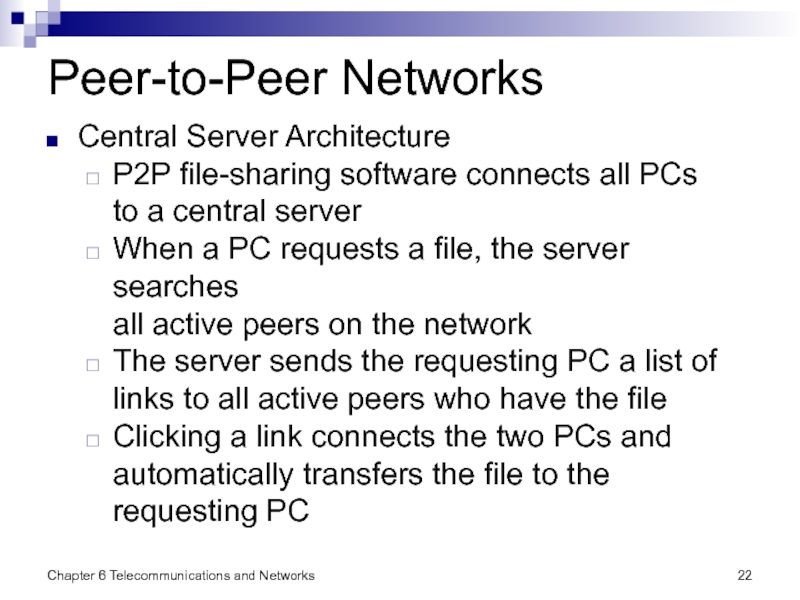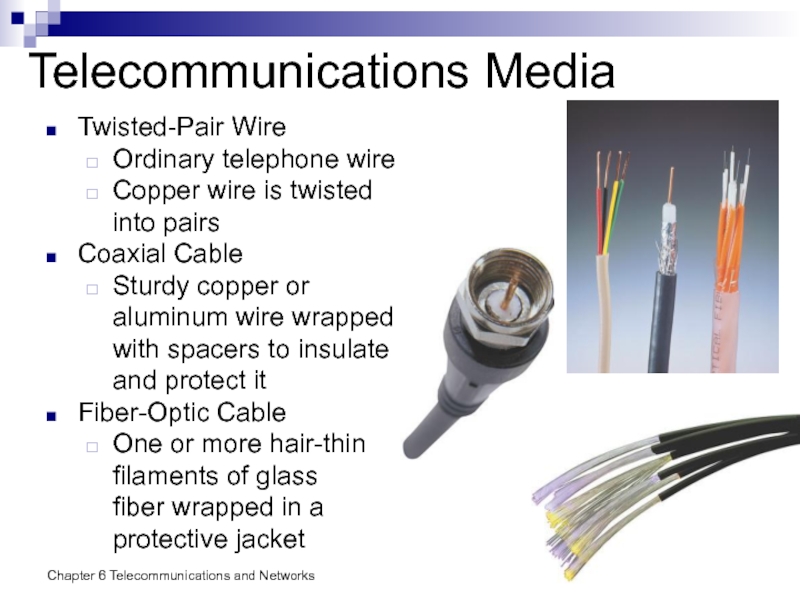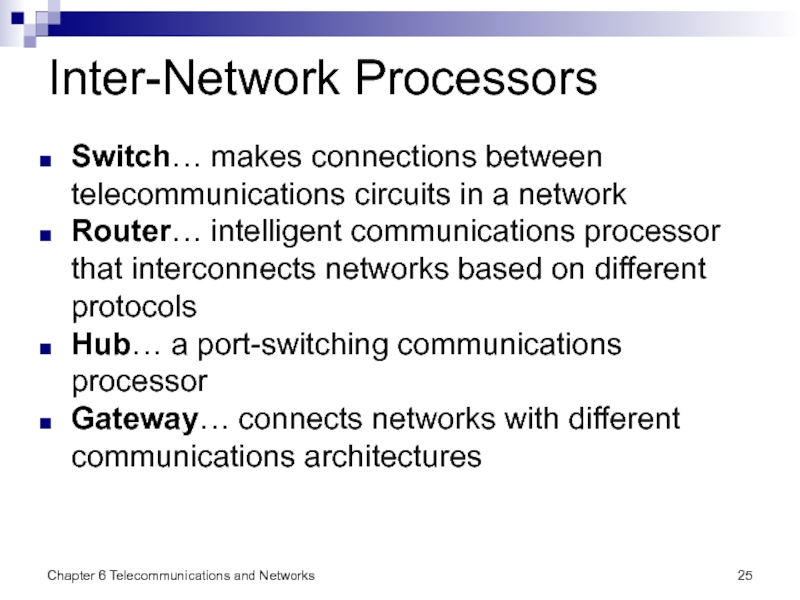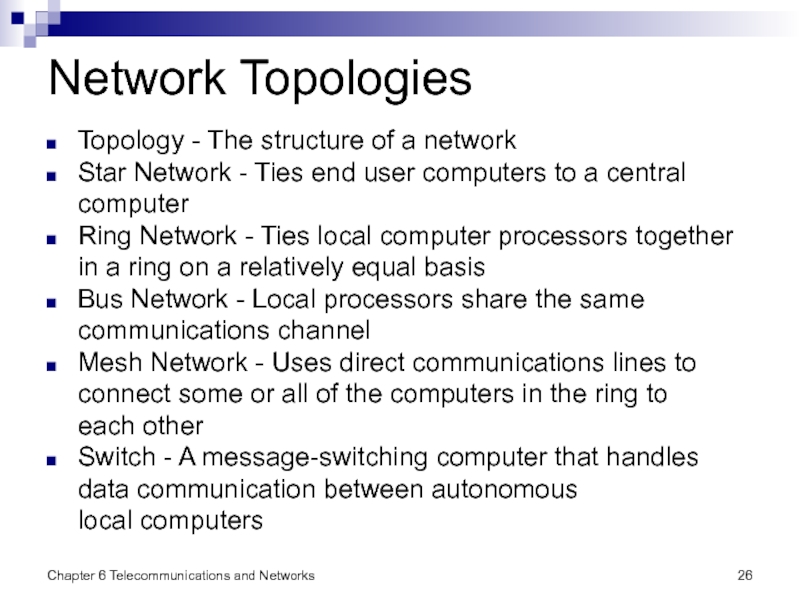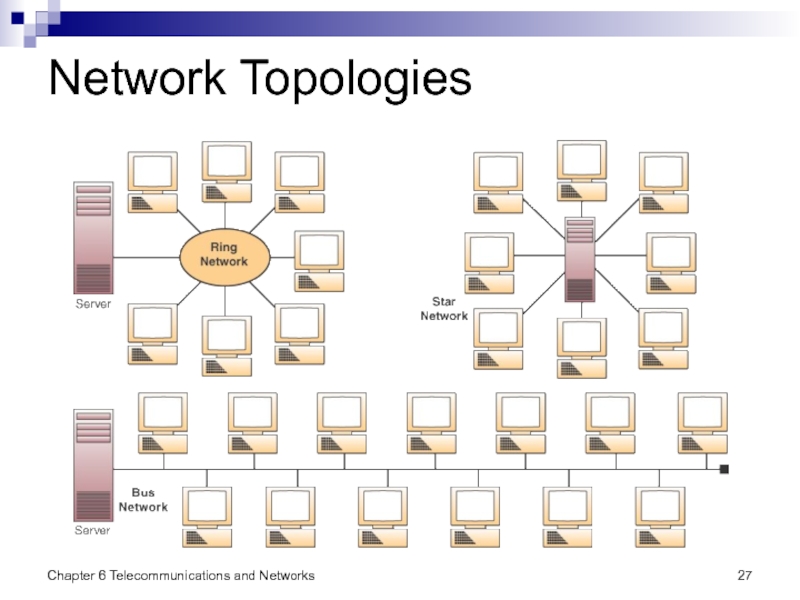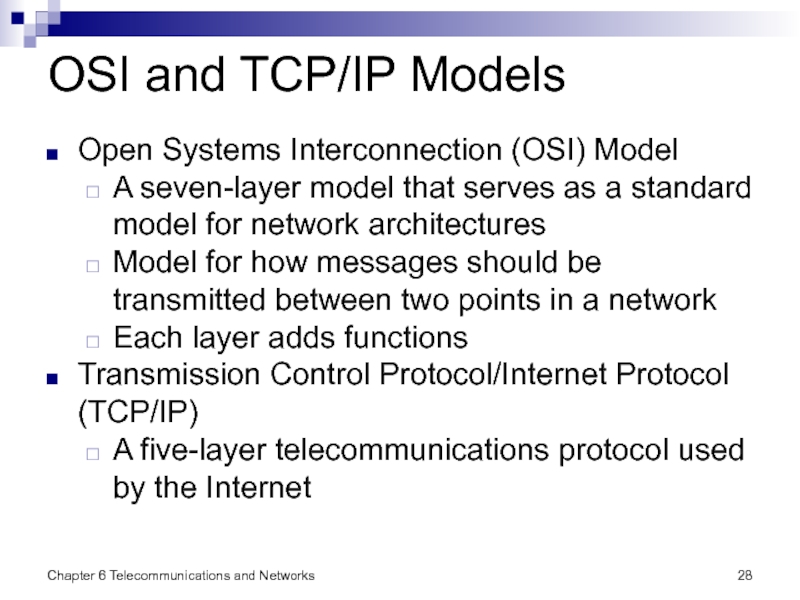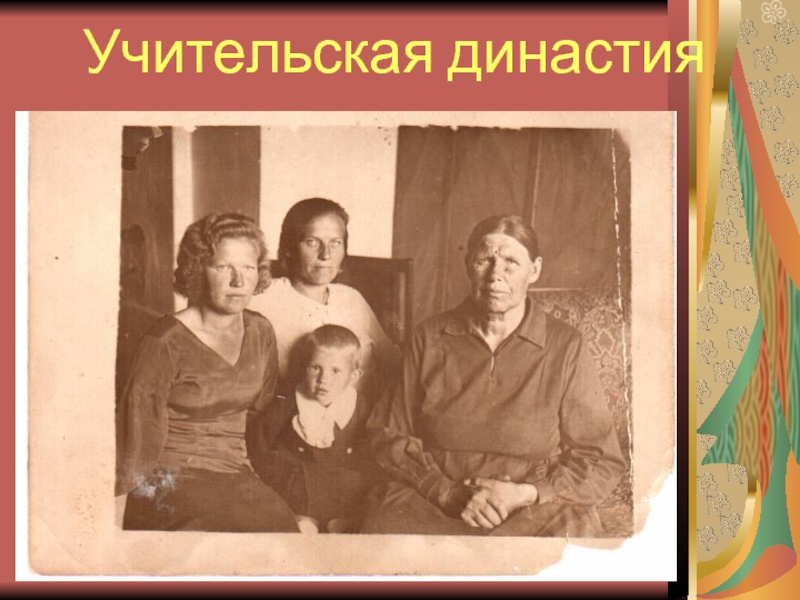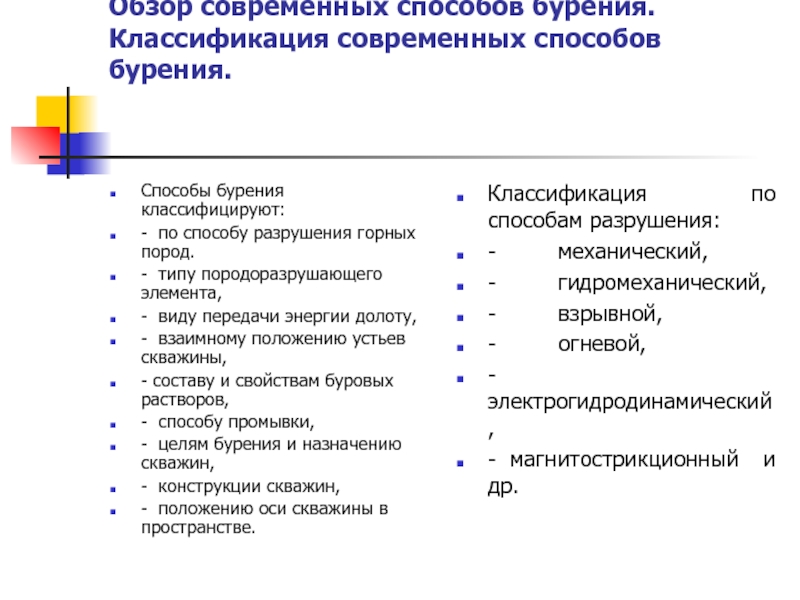- Главная
- Разное
- Дизайн
- Бизнес и предпринимательство
- Аналитика
- Образование
- Развлечения
- Красота и здоровье
- Финансы
- Государство
- Путешествия
- Спорт
- Недвижимость
- Армия
- Графика
- Культурология
- Еда и кулинария
- Лингвистика
- Английский язык
- Астрономия
- Алгебра
- Биология
- География
- Детские презентации
- Информатика
- История
- Литература
- Маркетинг
- Математика
- Медицина
- Менеджмент
- Музыка
- МХК
- Немецкий язык
- ОБЖ
- Обществознание
- Окружающий мир
- Педагогика
- Русский язык
- Технология
- Физика
- Философия
- Химия
- Шаблоны, картинки для презентаций
- Экология
- Экономика
- Юриспруденция
Telecommunications and Networks презентация
Содержание
- 1. Telecommunications and Networks
- 2. Communications Communications The message (data and information)
- 3. -The transmission of data from one computer
- 4. Telecommunications Telecommunications The electronic transmission of signals
- 5. Communications and Telecommunications In human speech, the
- 6. Chapter 6 Telecommunications and Networks
- 7. Data Communications Data communications A specialized subset
- 8. Computer Network Computer network… The communications media,
- 9. Chapter 6 Telecommunications and Networks Telecommunications-Based Services
- 10. Chapter 6 Telecommunications and Networks Internet Networking
- 11. Chapter 6 Telecommunications and Networks Open Systems
- 12. Chapter 6 Telecommunications and Networks Digital Network
- 13. Chapter 6 Telecommunications and Networks Telecommunications Network
- 14. Chapter 6 Telecommunications and Networks Telecommunications Network
- 15. Chapter 6 Telecommunications and Networks Network Component Alternatives
- 16. Chapter 6 Telecommunications and Networks Types of
- 17. Chapter 6 Telecommunications and Networks Wide Area
- 18. Chapter 6 Telecommunications and Networks Local Area
- 19. Chapter 6 Telecommunications and Networks Virtual Private
- 20. Chapter 6 Telecommunications and Networks Client/Server Networks
- 21. Chapter 6 Telecommunications and Networks Client/Server Network
- 22. Chapter 6 Telecommunications and Networks Peer-to-Peer Networks
- 23. Chapter 6 Telecommunications and Networks Telecommunications Media
- 24. Chapter 6 Telecommunications and Networks Telecommunications Processors
- 25. Chapter 6 Telecommunications and Networks Inter-Network Processors
- 26. Chapter 6 Telecommunications and Networks Network Topologies
- 27. Chapter 6 Telecommunications and Networks Network Topologies
- 28. Chapter 6 Telecommunications and Networks OSI and
Слайд 2Communications
Communications
The message (data and information) is communicated via the signal
The transmission
medium “carries” the signal
Слайд 3 -The transmission of data from one computer to another, or from
one device to another. A communications device, therefore, is any machine that assists data transmission. For example, modems, cables, and ports are all communications devices. Communications software refers to programs that make it possible to transmit data.
Слайд 4Telecommunications
Telecommunications
The electronic transmission of signals for communications, including such means as:
Telephone
Radio
Television
Telecommunication
medium
Anything that carries an electronic signal and interfaces between a sending device and a receiving device
Anything that carries an electronic signal and interfaces between a sending device and a receiving device
Chapter 6 Telecommunications and Networks
Слайд 5Communications and Telecommunications
In human speech, the sender transmits a signal through
the transmission medium of the air
In telecommunications, the sender transmits a signal through the transmission medium of a cable
In telecommunications, the sender transmits a signal through the transmission medium of a cable
Chapter 6 Telecommunications and Networks
Слайд 7Data Communications
Data communications
A specialized subset of telecommunications that refers to the
electronic collection, processing, and distribution of data -- typically between computer system hardware devices
Слайд 8Computer Network
Computer network…
The communications media, devices, and software needed to connect
two or more computer systems and/or devices
Used to share hardware, programs, and databases across the organization
Used to share hardware, programs, and databases across the organization
Слайд 10Chapter 6 Telecommunications and Networks
Internet Networking Technologies
Internet networking technologies are being
used as technology platform
Web browser suites
HTML Web page editors
Network management software
Firewalls
Being applied in Internet, intranet, and extranet applications
Reinforces previous move toward client/server networks based on open-systems architecture
Web browser suites
HTML Web page editors
Network management software
Firewalls
Being applied in Internet, intranet, and extranet applications
Reinforces previous move toward client/server networks based on open-systems architecture
Слайд 11Chapter 6 Telecommunications and Networks
Open Systems
Open systems use common standards for
hardware, software, applications, and networks
Internet networking technologies are a common standard for open systems
Connectivity
Open systems provide greater connectivity and network interoperability
Middleware may be needed to help diverse systems work together
Internet networking technologies are a common standard for open systems
Connectivity
Open systems provide greater connectivity and network interoperability
Middleware may be needed to help diverse systems work together
Слайд 12Chapter 6 Telecommunications and Networks
Digital Network Technologies
Telecommunications are being revolutionized by
switch from analog to digital
Analog: voice-oriented transmission
Digital: discrete pulse transmission
Benefits
Higher transmission speeds
Moves larger amounts of information
Greater economy and much lower error rates
Transmits multiple types of communications (data, voice, video) on the same circuits
Analog: voice-oriented transmission
Digital: discrete pulse transmission
Benefits
Higher transmission speeds
Moves larger amounts of information
Greater economy and much lower error rates
Transmits multiple types of communications (data, voice, video) on the same circuits
Слайд 13Chapter 6 Telecommunications and Networks
Telecommunications Network Components
Terminals
Any input/output device that uses
networks
to transmit or receive data
Telecommunications processors
Devices that support data transmission, reception
Telecommunications channels
Media over which data are transmitted, received
Computers
All sizes and types
Telecommunications processors
Devices that support data transmission, reception
Telecommunications channels
Media over which data are transmitted, received
Computers
All sizes and types
Слайд 14Chapter 6 Telecommunications and Networks
Telecommunications Network Components
Telecommunications control software
Controls telecommunications activities
Manages
the functions of telecommunications networks
Includes network management programs of all kinds
Telecommunications monitors (mainframes)
Network operating systems (network servers)
Web browsers (microcomputers)
Includes network management programs of all kinds
Telecommunications monitors (mainframes)
Network operating systems (network servers)
Web browsers (microcomputers)
Слайд 16Chapter 6 Telecommunications and Networks
Types of Communications Networks
Primary types of communications
networks
Wide Area
Local Area
Virtual Private
Client/Server
Peer-to-peer
Wide Area
Local Area
Virtual Private
Client/Server
Peer-to-peer
Слайд 17Chapter 6 Telecommunications and Networks
Wide Area Network (WAN)
Telecommunication network that covers
a large geographic area
Слайд 18Chapter 6 Telecommunications and Networks
Local Area Network (LAN)
Connects computers within a
limited physical area, such as an office, classroom, or building
Слайд 19Chapter 6 Telecommunications and Networks
Virtual Private Networks (VPN)
Used to establish secure
intranets and extranets
The Internet is the main backbone network
Relies on network firewalls, encryption, and other security features to build a “pipe” through the Internet
Creates a private network without the high cost of a separate proprietary connection
The Internet is the main backbone network
Relies on network firewalls, encryption, and other security features to build a “pipe” through the Internet
Creates a private network without the high cost of a separate proprietary connection
Слайд 20Chapter 6 Telecommunications and Networks
Client/Server Networks
Clients
End user personal computers or networked
computers
Servers
Used to manage the networks
Processing
Shared between the clients and servers
Sometimes called a two-tier architecture
Larger computer systems are being replaced with multiple client/server networks
Servers
Used to manage the networks
Processing
Shared between the clients and servers
Sometimes called a two-tier architecture
Larger computer systems are being replaced with multiple client/server networks
Слайд 22Chapter 6 Telecommunications and Networks
Peer-to-Peer Networks
Central Server Architecture
P2P file-sharing software connects
all PCs
to a central server
When a PC requests a file, the server searches all active peers on the network
The server sends the requesting PC a list of links to all active peers who have the file
Clicking a link connects the two PCs and automatically transfers the file to the requesting PC
When a PC requests a file, the server searches all active peers on the network
The server sends the requesting PC a list of links to all active peers who have the file
Clicking a link connects the two PCs and automatically transfers the file to the requesting PC
Слайд 23Chapter 6 Telecommunications and Networks
Telecommunications Media
Twisted-Pair Wire
Ordinary telephone wire
Copper wire is
twisted
into pairs
Coaxial Cable
Sturdy copper or aluminum wire wrapped with spacers to insulate and protect it
Fiber-Optic Cable
One or more hair-thin filaments of glass fiber wrapped in a protective jacket
Coaxial Cable
Sturdy copper or aluminum wire wrapped with spacers to insulate and protect it
Fiber-Optic Cable
One or more hair-thin filaments of glass fiber wrapped in a protective jacket
Слайд 24Chapter 6 Telecommunications and Networks
Telecommunications Processors
Modems
The most common type of communications
processor
Converts a digital signal to an analog frequency that can be transmitted over phone lines, then back into a digital signal
Converts a digital signal to an analog frequency that can be transmitted over phone lines, then back into a digital signal
Слайд 25Chapter 6 Telecommunications and Networks
Inter-Network Processors
Switch… makes connections between telecommunications circuits
in a network
Router… intelligent communications processor that interconnects networks based on different protocols
Hub… a port-switching communications processor
Gateway… connects networks with different communications architectures
Router… intelligent communications processor that interconnects networks based on different protocols
Hub… a port-switching communications processor
Gateway… connects networks with different communications architectures
Слайд 26Chapter 6 Telecommunications and Networks
Network Topologies
Topology - The structure of a
network
Star Network - Ties end user computers to a central computer
Ring Network - Ties local computer processors together in a ring on a relatively equal basis
Bus Network - Local processors share the same communications channel
Mesh Network - Uses direct communications lines to connect some or all of the computers in the ring to each other
Switch - A message-switching computer that handles data communication between autonomous local computers
Star Network - Ties end user computers to a central computer
Ring Network - Ties local computer processors together in a ring on a relatively equal basis
Bus Network - Local processors share the same communications channel
Mesh Network - Uses direct communications lines to connect some or all of the computers in the ring to each other
Switch - A message-switching computer that handles data communication between autonomous local computers
Слайд 28Chapter 6 Telecommunications and Networks
OSI and TCP/IP Models
Open Systems Interconnection (OSI)
Model
A seven-layer model that serves as a standard model for network architectures
Model for how messages should be transmitted between two points in a network
Each layer adds functions
Transmission Control Protocol/Internet Protocol (TCP/IP)
A five-layer telecommunications protocol used by the Internet
A seven-layer model that serves as a standard model for network architectures
Model for how messages should be transmitted between two points in a network
Each layer adds functions
Transmission Control Protocol/Internet Protocol (TCP/IP)
A five-layer telecommunications protocol used by the Internet
